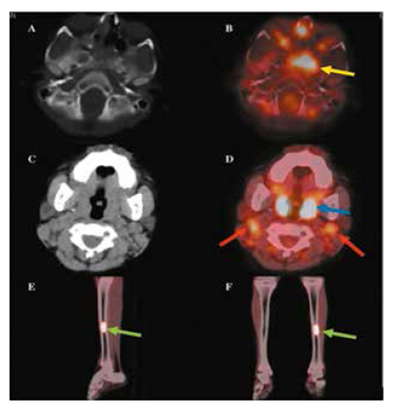INTRODUCTION
Rosai-Dorfman-Destombes disease (RDD) is a rare non-Langerhans cell histiocytosis, with sinus involvement and massive lymphadenopathy 1). RDD prevalence is 1:200 000, having a predilection for men, the mean age of presentation is 20,6 years, being more frequent in children 2). RDD is usually self-limited; it can appear alone or related to other diseases (autoimmune or malignancy) 3. Extranodal disease can present in 43 % patients 3). The involvement of head/neck is described in 11 % of patients producing symptoms due to mass effect 4,5). Bone involvement occurs in 5 % to 10 %, the most common symptom is bone pain, however pathologic fracture can occur (diaphysis and metaphysis affection) 4). The published cases of 18F-FDG PET/CT in the RDD, report avidity of FDG radiotracer by the injuries, this is a powerful diagnostic tool; a full body scan can diagnose with high specificity the extranodal involvement 6). The purpose of this clinical case is to describe the metabolic characteristics of 18F-FDG-PET/CT in Rosai-Dorfman-Destombes disease.
CASE REPORT
We present a 9-year-old male, with 5-months characterized by headache in the left side of the head, eye pain, obstruction of the left nostril, explosive vomiting, mouth breathing, and nighttime snoring. In the physical exam, the main finding was a mass in the left nostril occluding the entire lumen. A biopsy of that lesion was taken, giving as result a benign histiocytosis, compatible with RDD. Subsequently the patient was scanned with full body 18F-FDG PET/CT, the image acquisition after 60 minutes, PET/CT equipment (Philips Gemini TF). The results of the study showed hypermetabolic focal lesions in the sphenoid sinus, ethmoid sinus, and bilateral nasal involvement, SUVmax in 8.3, increasing to 13.8 in late control, associated with hypermetabolic focal injury in the middle third of the left tibia with SUVmax in 9.6, findings in relation to high-grade expansive injury (Figure 1). Multiple bilateral cervical lymphadenopathies with SUVmax in 7.0 suggestive of nodal involvement. The patient was started with a combined treatment consisting of 6-MP, methotrexate, and vinblastine.

Figure 1. 18F-FDG-PET/CT Results: Axial CT (A) and axial fused (B) images showing focal hypermetabolic intake in the sphenoid lesion (yellow arrow). Axial CT (C) and axial fused (D) images showing focal hypermetabolic intake in the bilateral nasal cavity (blue arrow) and bilateral latero-cervical nodes (red arrow). Sagittal CT fused (E) and coronal CT fused (F) images showing focal hypermetabolic intake in the medial diaphysis of the left tibia (green arrows).
DISCUSSION
RDD has been described a few thousand times in all medical records. The typical clinical presentation of this patient was helpful for establishing the diagnosis. Nevertheless, RDD can be confused with many other diseases that produce generalized lymphadenopathy, from infectious etiologies to neoplasm. A misleading diagnosis would cause harmful outcomes due to inadequate treatment. In the setting of a low-income country as Peru, this case commonly can be confused with Mycobacterium tuberculosis infection, delaying the RDD treatment. In early 2018, there was an effort to create diagnostic criteria and treatment guidelines to unify the disease management. In Abla O, et al. 2018, mention that some authors recommend PET/CT scan for all patients, the study of 18F-FDG PET/CT as part of the diagnostic process demonstrated avid FDG lesions at nodal and extranodal sites. It is evident that 18F-FDG PET/CT not only locates the disease but can be used in monitoring and/or evaluating response to treatment. More studies are required to determine the exact role of 18F-FDG PET/CT in this pathology.















